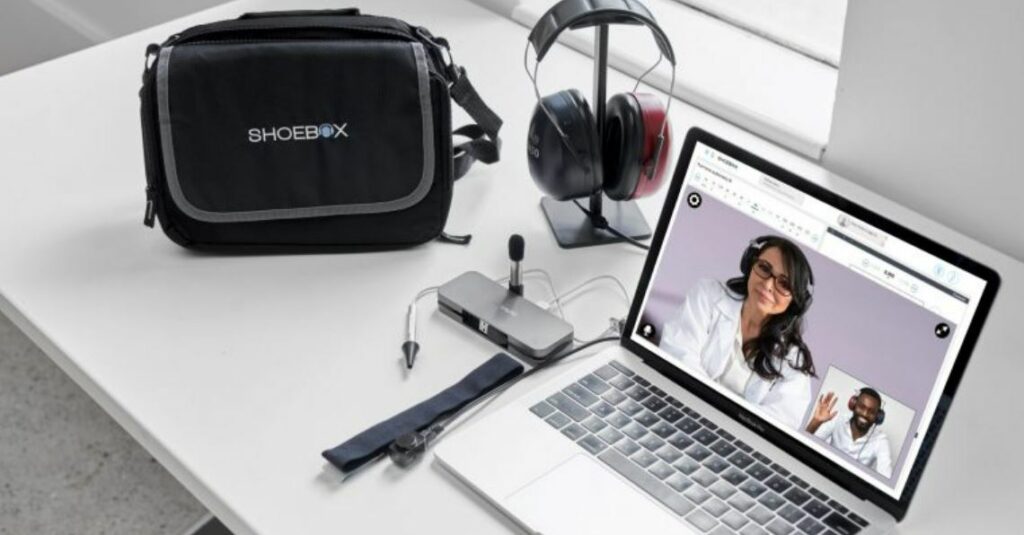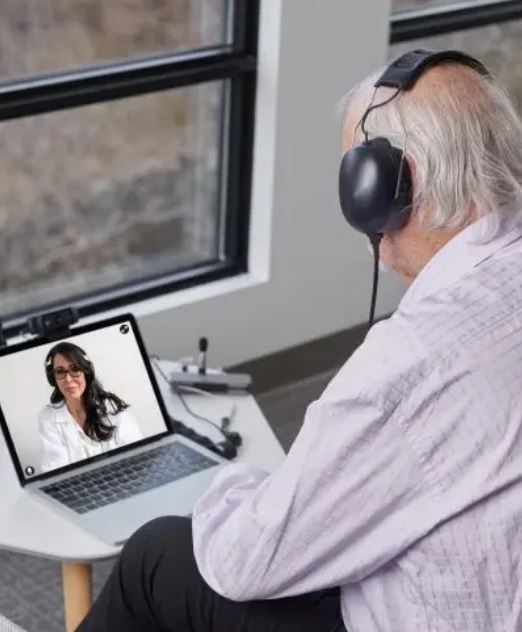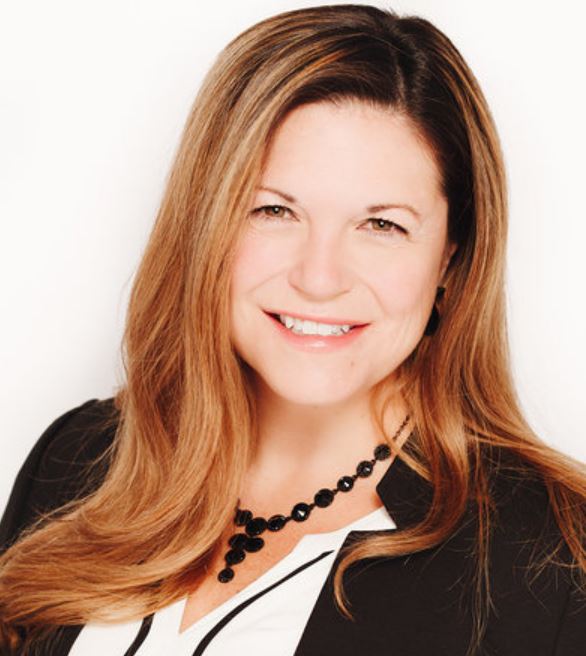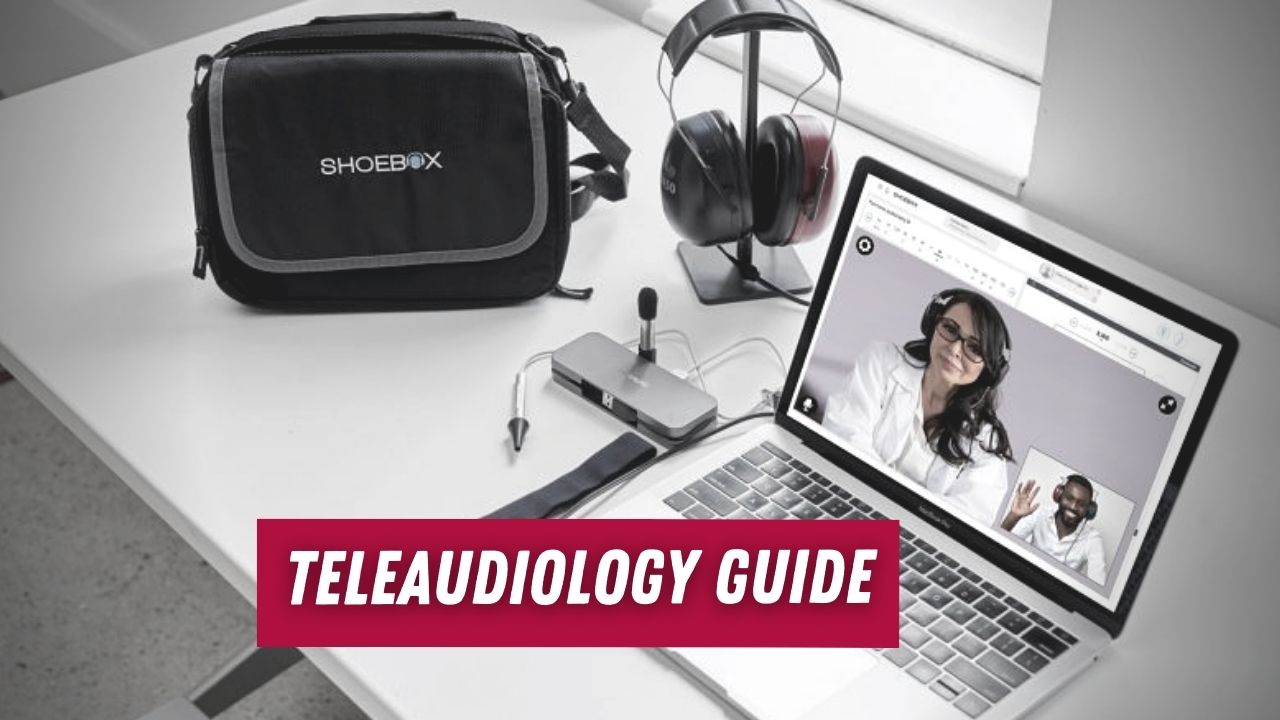Table of Contents:
- History of Teleaudiology
- What is Teleaudiology
- Understanding the Need for Teleaudiology
- Advantages of Teleaudiology for Patients and Providers
- Teleaudiology is Effective
- How SHOEBOX Can Help
- SHOEBOX for Teleaudiology
- Teleaudiology Video Conferencing Tips
- Conclusion
Introduction to Teleaudiology
When the winds of change blow, some people build walls; others build windmills. This ancient Chinese proverb has been particularly pertinent in recent years.
A global pandemic has compelled us to rethink how we live, work and interact with the rest of the world. However, much remains to be determined in our collective new normal and audiology is no exception.
We took for granted many aspects of our day that were previously routine, such as providing regular patient check-ups, follow-ups and acute hearing care. However, when hearing diagnostics and hearing loss intervention became more challenging, many audiologists adapted – building windmills rather than walls. The evolution and adoption of teleaudiology before and during the pandemic is one of the most significant examples of innovation that the audiology industry has experienced in decades. The future of teleaudiology is happening here and now, and this exciting shift rapidly transforms how hearing care is delivered.
History of Teleaudiology
Teleaudiology has a history that goes back long before the pandemic. The term teleaudiology was reportedly first coined by Dr. Gregg Givens in 1999, referring to a system being developed at East Carolina University. Soon afterwards, Dr. Givens and his associates completed the first known Internet-delivered audiological test in 2000.
This research and testing led to the first transatlantic remote teleaudiology evaluation in 2009 by Dr. James Hall for a patient in South Africa from the American Academy of Audiology conference in Dallas, TX. 1
Teleaudiology has continued to grow in popularity for diagnostics, pediatric audiology, rehabilitation, cochlear implants (CIs), neonatal hearing screening and hearing aids (HAs). Even when faced with considerable distance, teleaudiology has proven to be an effective way of narrowing the gap between patients and hearing healthcare providers. In addition, advances in Internet connectivity and computer technology, and the sudden demand for remote hearing assessments over the pandemic, have resulted in more adoption of teleaudiology as a standard form of care.
What is Teleaudiology?
In the most simplistic terms, teleaudiology is the remote delivery of audiology services. Teleaudiology is an audiological service delivery method that allows for care outside a traditional audiology clinic or hospital without the patient and audiologist meeting in person. Instead, both the interaction and exchange of information is delivered over Internet-powered communication tools.
Teleaudiology strategies can vary considerably; they can be as simple as a virtual hearing screening on a website or be as sophisticated as a remote appointment using tele-audiological equipment, delivering a high level of clinical accuracy for the clinician. Remote hearing healthcare’s advantages are broad in nature, from aural rehabilitation to tinnitus counseling classes to remote diagnostic testing – this model of delivery offers so much.
There are two broad delivery methods of teleaudiology – asynchronous and synchronous.
- Asynchronous Teleaudiology
Audiological test results are captured, saved and forwarded for further interpretation to a hearing care professional for any next steps and interpretation. Asynchronous teleaudiology does not require real-time interaction; typically, the patient and trained technician communicate utilizing email. The patient interacts with a trained hearing technician to gather all the data to be sent to an audiologist for interpretation, recommendations, and subsequent next steps. - Synchronous Teleaudiology
Synchronous teleaudiology is a remote hearing care method employed by clinicians who prefer real-time patient interaction, and it more resembles a traditional appointment. The hearing care professional utilizes two-way video conferencing technology to control remote testing with a technician or audiology assistant present on-site with the patient. The trained technician can perform otoscopy, headphone placement and other testing required by the audiologist to facilitate the remote appointment. This form of teleaudiology can address a wide range of hearing care needs, including hearing aid fittings, audiometry, and counseling.
Patient-led synchronous teleaudiology grew in popularity due to the necessity for social distancing during the pandemic. An adapted home model allows the patient to take charge of testing by using teleaudiology equipment shipped to the person’s home while meeting with a hearing care professional over video-conferencing tools.
A clinician can use a combination of asynchronous and synchronous teleaudiology practices to best suit their needs and the needs of their patients.

Clinicians can use a combination of asynchronous and synchronous teleaudiology practices to best suit their needs and those of their patients.
Understanding the Need for Teleaudiology
The impact of teleaudiology is wide-reaching and global. Unfortunately, there are not enough audiologists or hearing instrument specialists to address the ever-increasing demand for hearing healthcare. Close to 80 percent of individuals living with hearing loss do not have access to hearing care services because they live in regions of the world with a shortage of working audiologists and hearing care professionals 2. The scarcity of hearing care options is particularly prevalent in the developing world.
This lack of audiological care also affects people in America, with the demand for audiological services overextending delivery capacity. This problem is compounded by the fact that our aging population continues to grow, creating bottlenecks in hearing healthcare and causing delays in this age group accessing care in a timely and convenient manner.
According to a 2013 study conducted by Windmill & Freeman, the number of people entering the audiology field will need to increase by 50 percent immediately, while attrition rates must be reduced to 20 percent to satisfy the American population’s need for hearing healthcare 3. Further embracing teleaudiology would optimize audiological service delivery and grow access to patient care.
Teleaudiology removes distance as a barrier when it comes to patient care delivery. In addition, recruiting experienced hearing professionals becomes more manageable when drawing from an entire region rather than a talent pool limited by commuting times.

Teleaudiology can help remove distance as a barrier for hearing care delivery
A 2019 Journal of Community Health study examined the correlation between the care received in an American rural area and that encountered in an urban region. The study looked at 40 children born with severe congenital sensorineural hearing loss, with the timing of diagnostic and therapeutic services compared between the two regions. The children from the rural areas obtained amplification at a median age of 47.7 weeks after birth, while the children in urban areas accessed amplification at 26 weeks. In addition, cochlear implantation happened at 182 weeks after birth for children born in rural areas, while urban-dwelling children only waited 104 weeks 4.
Unfortunately, the findings in the study mentioned above are not uncommon in America and are not limited to pediatric patients. The 2000 US Census found that approximately 20 percent of Americans reside in rural areas 5 and are often distanced from hearing care.
People of all ages throughout America and worldwide cannot easily access the vital hearing care they require and deserve. Teleaudiology is a clinically proven, leading-edge route to ease the divide between rural and urban, young and old and everyone in between.
Advantages of Teleaudiology for Patients and Providers
Teleaudiology can help reduce the hurdles encountered by both patients and providers. For patients, teleaudiology opens the door to expanded care by potentially shortening travel distances, decreasing wait times for appointments and helping patients obtain hearing care that may not have been possible otherwise. For providers, teleaudiology can boost efficiencies in providing care: by using remote testing, audiologists can optimize their schedules and test from anywhere as the physical location of a clinic does not bind them.
The advantages of virtual remote audiology are numerous and it is essential that clinicians adopt teleaudiology because:
- It is needed – We are facing a reality where more and more people cannot access the hearing care they require due to a shortage of hearing healthcare professionals. Not all patients drive or have access to required transportation.
- It is convenient – Teleaudiology is convenient to both the patient and provider. Time is saved by no longer needing to travel long distances for appointment interactions.
Teleaudiology encourages patients to take more ownership of their hearing health by giving them greater access to care (especially for those living in remote locations) and providing a higher level of scheduling flexibility. Convenient and accessible care is essential in optimizing hearing care for everyone.
Teleaudiology is Effective
A recent study published in the International Journal of Audiology analyzed the accuracy of online digital audiometry compared to conventional audiometric equipment. A total of 41 participants completed audiometric testing using conventional in-person audiometry, which was then compared to same-day results of cloud-based remote audiometry. Test selection was performed in random order, and both of the participants’ ears were tested.
The study concluded that online audiometry testing was as accurate as traditional audiometry, with a mean difference remaining within 5 dB HL for both air bone conduction thresholds at all testing frequencies 8.
How SHOEBOX Can Help
At SHOEBOX, we believe the future of audiology is happening today. Our web-based family of hearing testing solutions was developed to enhance the patient experience, increase efficiencies, provide versatility and reduce cost. Whether you are an independant audiologist looking to improve your audiological testing or a large chain retailer, we have a full range of audiometric testing tools to support your day-to-day operations.
We’ve designed our tools to grow and adapt to your needs. Our web-based innovative technology allows you the ability to offer:
- Pre-appointment awareness and screening
- Teleaudiology
- In-clinic audiometry diagnostic testing
- Portable diagnostic testing
- HIPAA and GDPR compliant hearing testing.
Our tools offer you a centralized data management system integrated with your NOAH database.
SHOEBOX for Teleaudiology
An evident demand for expanded access to hearing healthcare, coupled with advancements in remote hearing testing technology, has made teleaudiology an appealing solution for today’s practitioners.
Teleaudiology is here to stay, and at SHOEBOX, we want to be your partner in this journey.
We offer a web-based family of hearing testing solutions that facilitate both asynchronous and synchronous teleaudiology models of care.
The SHOEBOX solution consists of SHOEBOX Online, SHOEBOX Remote and SHOEBOX Consult. These solutions power all stages of a patient’s hearing care journey – from pre-appointment awareness and screening (SHOEBOX Online) to diagnostic testing and first fit, and then finally to fine-tuning adjustments. Clinicians can develop a workflow that fits their personal requirements, with SHOEBOX Remote being utilized for remote testing and SHOEBOX Consult employed for an in-clinic diagnostic model.

From pre-appointment awareness and screening, to diagnostic testing and first fit. Clinicians can develop a workflow that works best for their clinic
SHOEBOX Remote allows for teleaudiology at remote clinics or at home for clinicians by delivering the following features:
- Synchronous remote diagnostic hearing testing;
- The ability to seamlessly perform air conduction and bone conduction testing, speech testing, and self-directed video-otoscopy;
- The ability to expand access to hearing services;
- The ability to provide comprehensive telehealth while a patient is at a remote clinic or at home;
You will immediately have the power to conduct audiometric assessments with patients anywhere and anytime (ambient noise levels considered).
The foundation of any sustainable teleaudiology strategy is accurate and robust testing equipment. Coupled with SHOEBOX equipment, your PC will be instantly transformed into a powerful cloud-centralized audiometry system. Plug in the supported transducers, microphone(s) and video-otoscope, into the USB hub. All that’s required is a computer with a supported operating system (OS), camera, microphone and speaker.
Teleaudiology Video Conferencing Tips
Clinicians new to teleaudiology may have questions about how to best interact with patients over video. Our platform and its built-in video conferencing capability capture the technical aspects of your teleaudiology appointment effortlessly. All that is required is for the patient and remote clinician to have access to a supported computer, a Chrome browser, microphones and web cameras.
Here are some helpful tips to make your video conference experience run smoothly:
- The remote clinician should always ensure their microphone is muted during active testing activities.
- Angle your camera in a position that allows your patients to see an up-close view of your face to promote better engagement.
- Ensure that you have sufficient lighting and be mindful of wearing plain-colored clothing and having a neutral, glare-free background to facilitate speech-reading. You can even turn off your camera during testing to reduce distractions for your patient.
- Invest in good Wi-Fi equipment to ensure a stable and strong Internet connection.
Conclusion
There are various benefits to using teleaudiology. One of the most significant advantages is greater access to care. Teleaudiology can connect millions of individuals in rural and urban areas to hearing care who are currently without it. In addition, teleaudiology has been proven to make hearing care options more cost-effective and more efficient by reducing travel times, as well as making testing a more manageable option for people living with mobility challenges. Furthermore, teleaudiology has proven to be secure, accurate and effective.
Acceptance by both clinicians and patients has always been one of the most significant factors in determining the success of telemedicine as a form of care. The COVID-19 pandemic not only increased awareness of teleaudiology for both patients and hearing care professionals, but it also improved acceptance. Teleaudiology is here to stay – it’s time to build windmills, not walls.
To learn more about our full teleaudiology solution at Shoebox, please contact us.
References:
- Tele-audiology – Wikipedia
- Tele-Audiology: Current State and Future Directions | Digital Health
- Demand for audiology services: 30-yr projections and impact on academic programs
- Timing discrepancies of early intervention hearing services in urban and rural cochlear implant recipients
- 2010 Census Urban and Rural Classification and Urban Area Criteria
- Nora Erkkola-Anttinen, Heikki Irjala, Miia K. Laine, Paula A. Tähtinen, Eliisa Löyttyniemi, and Aino Ruohola.Telemedicine and e-Health.Jun 2019.477-484.
https://doi.org/10.1089/tmj.2018.0062 - Full article: Online digital audiometry vs. conventional audiometry: a multi-centre comparative clinical study
- Teleaudiology 101
- Critical Steps in Establishing a Teleaudiology Practice
- A Review of Contemporary Teleaudiology: Literature Review, Technology, and Considerations for Practicing – PMC
About the Author
 Renée Lefrançois, M.Sc.(A), Reg. CASLPO, CAOHC PS/A Director of Audiology. Renée Lefrançois has been practicing audiology since 1999 and has been with SHOEBOX Ltd. since 2014. After 15 years of working with cochlear implants, she eagerly took on a new challenge of diving into diagnostics and hearing conservation for her current role as Director of Audiology. Renée leads both the internal Clinical Team at SHOEBOX, as well as the SBX External Audiology Network which provides state-licensed review and professional supervision services in the US and Canada. She lives in Ottawa, Canada and when not working, enjoys all things outdoors.
Renée Lefrançois, M.Sc.(A), Reg. CASLPO, CAOHC PS/A Director of Audiology. Renée Lefrançois has been practicing audiology since 1999 and has been with SHOEBOX Ltd. since 2014. After 15 years of working with cochlear implants, she eagerly took on a new challenge of diving into diagnostics and hearing conservation for her current role as Director of Audiology. Renée leads both the internal Clinical Team at SHOEBOX, as well as the SBX External Audiology Network which provides state-licensed review and professional supervision services in the US and Canada. She lives in Ottawa, Canada and when not working, enjoys all things outdoors.







